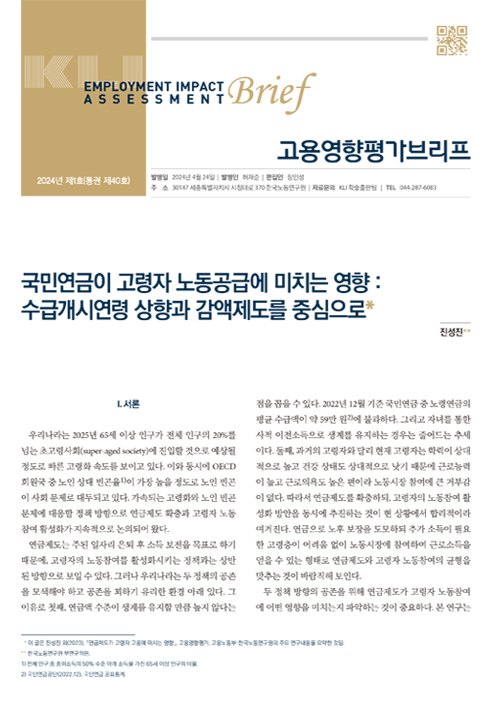한국노동연구원 'Research Series'에 대한 설명 입니다.
Research Series
Research Series

KLI Employment Impact Assessment Brief - 2024 No. 1 (Serial No. 40)
- Author Seongjin Jin
- Publication Date 2024.04.24
- Length 8
- ISBN
Content
I. Introduction
II. Overview of National Pension System
III. Analysis Methods
IV. Analysis Results
V. Conclusion and Policy Implications
Summary
Table of Contents
I. Introduction
II. Overview of National Pension System
III. Analysis Methods
IV. Analysis Results
V. Conclusion and Policy Implications
Summary
Korea is aging at such a rapid pace that it is expected to enter a super-aged society by 2025, when the number of people aged 65 and over will exceed 20% of the total population. At the same time, poverty among the elderly has emerged as a social problem, with the highest relative poverty rate among OECD countries. Expanding the pension system and activating the labor force participation of the elderly have been discussed as policy directions to respond to accelerating aging and poverty among the elderly.
Since the pension system is designed to maintain income after retirement from the main job, it may seem to contradict the policy of activating labor participation of the elderly. However, Korea is in a favorable environment to explore the coexistence of these two policies. First, pension benefits are not high enough to provide a livelihood. As of December 2022, the average old-age pension is only about 590,000 won, and private transfers from children are becoming less common. Second, unlike the elderly in the past, today's elderly have relatively high levels of education and good health, so they are highly capable and motivated to work, and they do not have much resistance to participating in the labor market. Therefore, it is reasonable to expand the pension system while promoting measures to activate the labor force participation of the elderly. It seems desirable to balance the pension system and the labor force participation of the elderly in such a way that the elderly who need additional income can easily participate in the labor market and earn income.
 Source Indication + Commercial Use Prohibition + Change Prohibition
Source Indication + Commercial Use Prohibition + Change Prohibition